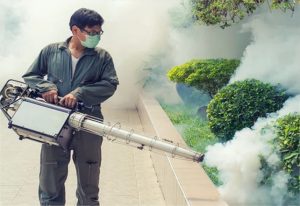The Comprehensive Guide to Tick Control: Safeguarding Your Home from Health Risks of Ticks
Ticks are more than just a nuisance; they are a significant health threat to both humans and pets, especially in areas like Essex, Middlesex Counties in Massachusetts, and Rockingham County New Hampshire. As vectors for illnesses such as Lyme disease, Rocky Mountain spotted fever, Anaplasmosis, Ehrlichiosis, and Babesiosis, these tiny pests can pose serious health risks if not effectively managed. For homeowners concerned about the safety of their families and pets, understanding tick prevention and control is essential. By implementing strategic measures to reduce tick exposure, you can protect your loved ones from the myriad dangers these pests bring. In this guide, we will delve into effective tick control strategies, equipping you with the knowledge to safeguard your home and enjoy peace of mind. For more information on tick-borne diseases and prevention strategies, refer to the CDC’s comprehensive guide.
Understanding the Health Risks of Ticks
Ticks pose significant health risks to both humans and pets. Understanding these risks is crucial for effective prevention and management. Let’s explore the common tick-borne diseases and their impact on pets and humans.
Common Tick-Borne Diseases
Ticks are notorious carriers of various diseases that can affect both humans and animals. Lyme disease is perhaps the most well-known, but it’s far from the only concern.
Rocky Mountain spotted fever is another serious tick-borne illness, characterized by fever, headache, and a distinctive rash. It can be life-threatening if not treated promptly.
Anaplasmosis and Ehrlichiosis are bacterial infections that can cause flu-like symptoms and, in severe cases, affect multiple organ systems. Babesiosis, a parasitic infection, can lead to anemia and other complications, especially in individuals with weakened immune systems.
Impact on Pets and Humans
The impact of tick-borne diseases on both pets and humans can be substantial, often leading to long-term health issues if left untreated.
For pets, especially dogs, Lyme disease can cause lameness, fever, and kidney problems. Cats are less susceptible but can still contract certain tick-borne illnesses. Regular check-ups and preventive measures are crucial for pet health.
In humans, the effects can range from mild, flu-like symptoms to severe neurological, cardiac, and joint problems. Long-term complications of untreated Lyme disease, for instance, can include chronic joint inflammation, cognitive difficulties, and heart rhythm irregularities.
Early detection and treatment are key to minimizing the impact of these diseases on both pets and humans.
Effective Tick Prevention Strategies
Preventing tick bites is the most effective way to avoid tick-borne diseases. This section covers essential strategies for tick prevention, focusing on landscaping, home maintenance, and personal protection measures.
Landscaping and Home Maintenance
Proper landscaping and home maintenance play a crucial role in tick control. By creating an environment less hospitable to ticks, you can significantly reduce their presence around your property.
Keep your lawn mowed short and remove leaf litter regularly. Ticks thrive in moist, shady areas, so maintaining a well-trimmed lawn exposes them to sunlight and reduces their habitat.
Create a barrier between wooded areas and your lawn using gravel or wood chips. This helps prevent ticks from migrating into your yard. Additionally, remove brush and weeds around your home’s foundation and at the edge of your lawn.
Consider using plants that naturally repel ticks, such as lavender, sage, and chrysanthemums, in your landscaping. While not a foolproof solution, these plants can contribute to an overall tick prevention strategy.
Personal Protection Measures
Personal protection is essential when spending time outdoors, especially in tick-prone areas. These measures can significantly reduce your risk of tick bites and subsequent disease transmission.
-
Wear appropriate clothing: Long sleeves, long pants tucked into socks, and closed-toe shoes create a barrier against ticks.
-
Use insect repellents: Apply EPA-registered repellents containing DEET, picaridin, or oil of lemon eucalyptus to exposed skin and clothing.
-
Treat clothing and gear: Use products containing 0.5% permethrin on clothing, boots, and camping gear for added protection.
After outdoor activities, conduct thorough tick checks on yourself, family members, and pets. Pay special attention to areas like the scalp, behind ears, under arms, and between legs.
If you find a tick, remove it promptly using fine-tipped tweezers. Grasp the tick as close to the skin’s surface as possible and pull upward with steady pressure. Clean the bite area and your hands with rubbing alcohol or soap and water.
Professional Tick Control Services
While personal prevention measures are crucial, professional tick control services can provide an additional layer of protection, especially in high-risk areas. These services offer expertise and specialized treatments to effectively manage tick populations around your property.www.mosquitoenemy.com
Benefits of Hiring Experts
Professional tick control services offer several advantages over DIY methods, making them a valuable investment for homeowners in tick-prone areas.
Experts have in-depth knowledge of tick behavior and habitat preferences, allowing them to target problem areas effectively. They use professional-grade products and equipment that may not be available to the general public, ensuring more thorough coverage and longer-lasting results.
Regular treatments by professionals can provide consistent protection throughout tick season. This proactive approach can significantly reduce the tick population on your property over time, lowering the risk of tick-borne diseases for your family and pets.
Additionally, professionals can offer valuable advice on ongoing prevention strategies tailored to your specific property and needs. This comprehensive approach combines treatment with education, empowering homeowners to maintain a tick-safe environment.
Service Areas in Essex, Middlesex, and Rockingham Counties
Our professional tick control services cover extensive areas within Essex, Middlesex, and Rockingham Counties, ensuring comprehensive protection for residents across these regions.
In Essex County, we serve major towns and cities including Lawrence, Lynn, and Salem. Our coverage extends to popular recreational areas and residential neighborhoods known for higher tick populations.
Middlesex County service areas include Lowell, Cambridge, and Framingham, among others. We prioritize regions with dense vegetation and wildlife habitats that are conducive to tick proliferation.
For Rockingham County, our services cover key areas such as Derry, Salem, and Portsmouth. We focus on both coastal and inland regions, addressing the diverse landscapes that contribute to tick presence in this county.
Our team is familiar with the specific tick-related challenges in each of these counties, allowing us to provide targeted and effective control measures. For detailed information on tick species prevalent in these areas, refer to the Maine Medical Center Research Institute’s Tick Handbook.







